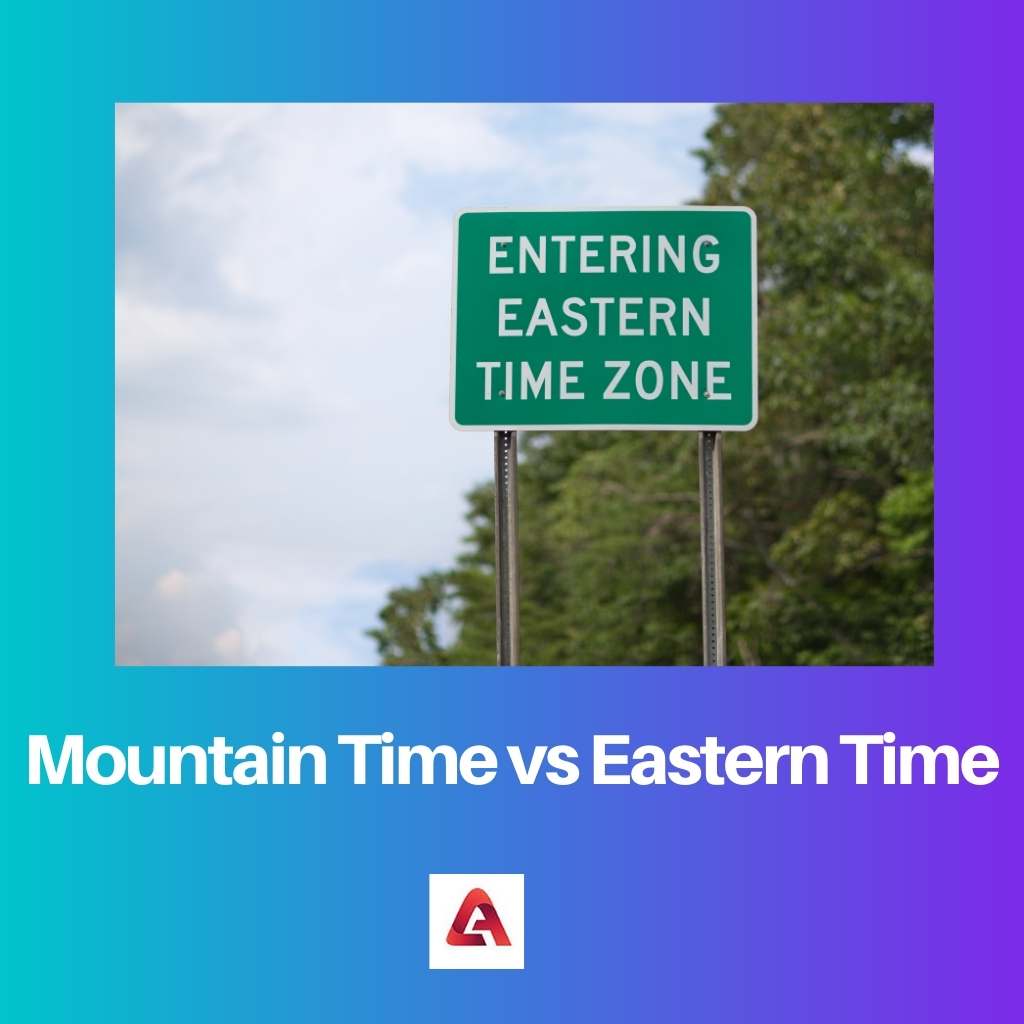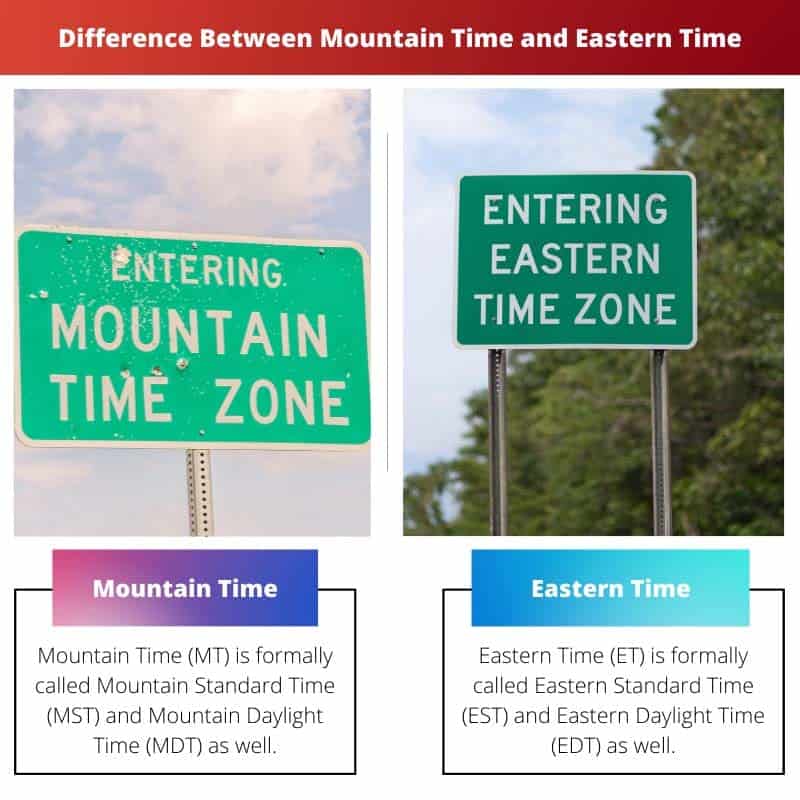North America has a total of six time zones, two of which are Mountain Time and Eastern Time. It is important to take note of them, especially for non-natives who plan on traveling through the place.
The task is not difficult since both Mountain Time and Eastern Time function in reference to the Coordinated Universal Time (UTC). However, there are numerous differences between the two zones.
Key Takeaways
- Mountain Time is two hours behind Eastern Time in the United States.
- Daylight Saving Time is observed in both time zones, with clocks adjusted forward one hour in spring and back one hour in fall.
- Coordinating events across time zones requires considering the time difference to ensure accurate scheduling.
Difference Between Mountain Time and Eastern Time
Mountain Time is seven hours behind Coordinated Universal Time (UTC-7) and is used in regions like Colorado, Utah, and Wyoming. Eastern Time is five hours behind Coordinated Universal Time (UTC-5) and is used in New York, Washington DC, and Miami. The direct difference is their time differences.

Mountain Time, however, has several variations. It is seven hours behind only when standard time is being practiced.
This is during autumn and winter. When daylight saving time is in effect, it keeps time six hours behind the UTC.
This means that six hours need to be deducted from UTC to calculate it during spring and summer. The case for Eastern time is pretty much similar to Mountain time.
However, it is only during the standard time that five hours need to be deducted from UTC. When daylight saving time is in effect, it works four hours behind the UTC.
So, people who follow Eastern time need to set their clocks differently for various reasons.
Comparison Table for Mountain Time vs Eastern Time
| Parameters of Comparison | Mountain Time | Eastern Time |
|---|---|---|
| Abbreviations | Mountain Time (MT) is formally called Mountain Standard Time (MST) and Mountain Daylight Time (MDT) as well. | Eastern Time (ET) is formally called Eastern Standard Time (EST) and Eastern Daylight Time (EDT) as well. |
| Location | It covers parts of Mexico, five provinces in Canada and 13 states in the US. | It covers Mexico, Central America, the Caribbean, 3 provinces in Canada, 23 states in the US. |
| Population | It is used by only 6.7% of the total population. | It is used by 47.6% of the total population. |
| During Standard Time | In autumn and winter, it is calculated by deducting seven hours from UTC. | During this period, it is calculated by deducting five hours from UTC. |
| During Daylight Saving Time | In spring and summer, it is calculated by deducting six hours from UTC. | During this period, it is calculated by deducting four hours from UTC. |
What is Mountain Time?
Mountain Time covers a smaller portion of the population as compared to Eastern Time. It spans across parts of Mexico, five provinces in Canada, and 13 states in the US.
Essentially, it keeps time with reference to the mean solar time at the 105th meridian. This is located to the west of the Greenwich Observatory.
Mountain Time is always calculated relative to the Coordinated Universal Time. It is always behind the UTC by dint of its western location.
However, it has clear distinctions for when standard time is in effect during autumn and winter and when daylight saving time is in effect during spring and summer. For autumn and winter, the time zone is referred to as Mountain Standard Time (MST).
During this period, it works seven hours prior to the UTC. This means that it must be calculated by deducting seven hours from the Coordinated Universal Time (UTC-7).
Meanwhile, mountain time is referred to as Mountain Daylight Time (MDT) during the spring and summer seasons. This is the period when daylight saving time is in full effect. MDT works six hours prior to UTC.
Therefore, it must be calculated by deducting six hours from the UTC (UTC-6).
How is Mountain Time Used?
- Coordination: Mountain Time serves as a reference point for scheduling and coordination within the regions it encompasses. It allows businesses, organizations, and individuals to establish consistent meeting times, deadlines, and operational hours. By aligning with a common time frame, businesses can coordinate their activities efficiently, fostering smoother interactions and improved productivity.
- Travel and Transportation: Mountain Time plays a significant role in the travel and transportation sectors. Airline schedules, train departures, and bus routes adhere to the local time of the departure and arrival locations. The usage of Mountain Time helps passengers plan their journeys and ensures a standardized system for travel-related operations within the region.
- Broadcasting and Communication: Media outlets, such as television and radio stations, utilize Mountain Time to synchronize programming schedules. Broadcasting networks tailor their programming to specific time zones, including Mountain Time, to ensure content reaches viewers at convenient times. Furthermore, communication between individuals, whether through phone calls, video conferences, or online meetings, frequently relies on the accurate coordination of Mountain Time.
Daylight Saving Time
Daylight Saving Time (DST) is a practice observed in many regions to use daylight better during the longer summer days. However, not all areas within the Mountain Time zone observe DST uniformly. Here’s how DST impacts the usage of Mountain Time:
- DST Observance: Several regions within the Mountain Time zone observe DST, advancing their clocks by one hour during summer. This adjustment, done in spring, allows for longer evening daylight. Areas such as Colorado, Idaho, Montana, New Mexico, Utah, and Wyoming adhere to DST, shifting from Mountain Standard Time (MST) to Mountain Daylight Time (MDT) during DST.
- Non-DST Observance: Conversely, some areas within the Mountain Time zone do not observe DST. For example, the state of Arizona remains on Mountain Standard Time (MST) throughout the year. This decision is based on local considerations, such as energy conservation, cultural preferences, or practicality.
What is Eastern Time?
Eastern Time covers a larger population than the former. While mountain time is only used by 6.7% of the total population, eastern time is used by a staggering 47.6%.
This is the most used time zone across the world. It spans across Mexico, Central America, and the Caribbean, 3 provinces in Canada, and 23 states in the US.
Like mountain time, eastern time is calculated relatively to UTC. It even has distinctions for standard time and daylight-saving time.
However, the time zone is located on the east side of Mountain Time. Therefore, it keeps time later than it.
In general, eastern time functions 2 hours later than mountain time. The time zone is called Eastern Standard Time (EST) for autumn and winter.
Here, the time is kept five hours before the UTC. This means it must be calculated by deducting five hours from the Coordinated Universal Time.
Furthermore, in spring and summer, eastern time is referred to as Eastern Daylight Time (EDT). During this period, the time is calculated by deducting four hours from the UTC.
So, people move their watches one hour forward, on the first Sunday of November. On the second Sunday of March, watches must be moved back by one hour.
How is Eastern Time Used?
- Business and Communication: Eastern Time is a common framework for businesses and individuals within the Eastern Time zone. It allows for efficient scheduling of meetings, appointments, and deadlines across various sectors. Organizations can coordinate their operations seamlessly with a consistent time reference, ensuring effective communication and productivity.
- Transportation and Travel: The transportation industry relies heavily on Eastern Time for planning and execution. Airlines, trains, and bus schedules adhere to the local time of their departure and arrival locations. Eastern Time enables travelers to plan their journeys and ensures a standardized system for managing transportation services within the Eastern Time zone.
- Media and Entertainment: Media outlets, such as television networks, radio stations, and streaming platforms, utilize Eastern Time to synchronize programming schedules. Broadcasting networks tailor their shows and events to specific time zones, including Eastern Time, to reach their intended audience at appropriate times. Additionally, major cultural and sporting events announce start times and airings in Eastern Time to provide a consistent reference for viewers.
Daylight Saving Time
Daylight Saving Time (DST) is a practice observed in many regions to optimize daylight usage during the longer days of summer. Here’s how DST impacts the usage of Eastern Time:
- DST Observance: Several areas within the Eastern Time zone observe DST, advancing their clocks by one hour during the summer months. This adjustment, implemented in spring, provides longer evening daylight. Regions such as the eastern United States, including New York, Washington D.C., and Florida, as well as parts of Canada, like Ontario and Quebec, adhere to DST, transitioning from Eastern Standard Time (EST) to Eastern Daylight Time (EDT) during DST.
- Non-DST Observance: Certain regions within the Eastern Time zone do not observe DST. For instance, areas in eastern Canada, such as Nova Scotia, New Brunswick, and some Caribbean islands, remain on Eastern Standard Time throughout the year. Various factors, including local preferences, energy conservation, and practicality influence the decision to opt-out of DST.
International Time Conversion
Eastern Time is a reference point for international time conversion, facilitating global interactions and coordination. Individuals or businesses engaged in international communication or trade use Eastern Time to convert their local time to establish mutual understanding across different time zones. Time conversion tools, such as online converters and world clocks, assist in determining the equivalent time in Eastern Time for scheduling purposes.
Main Differences Between Mountain Time and Eastern Time
- Mountain Time (MT) is formally called Mountain Standard Time (MST) and Mountain Daylight Time (MDT), whereas Eastern Time (ET) is formally called Eastern Standard Time (EST) and Eastern Daylight Time (EDT).
- Mountain time covers parts of Mexico, five provinces in Canada, and 13 states in the US whereas eastern time covers Mexico, Central America, and the Caribbean, with 3 provinces in Canada and 23 states in the US.
- Mountain time is used by only 6.7% of the total population, whereas Eastern time is used by 47.6% of the total population.
- In the effect of standard time, MST is calculated by deducting seven hours from UTC, whereas EST is calculated by deducting five hours from UTC during the same period.
- In the effect of daylight saving time, MDT is calculated by deducting six hours from UTC, whereas during the same period, EDT is calculated by deducting four hours from UTC.




